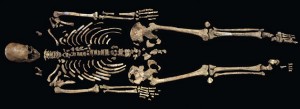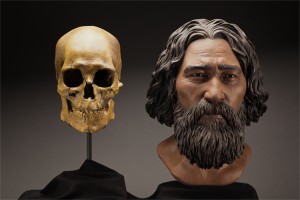Kennewick Man Comes Home
December 28, 2016
On Monday, December 19, U.S. President Barack Obama signed a bill ordering the return of an ancient human skeleton known as Kennewick Man to representatives of local Native American groups for reburial. The order signaled the end of a lengthy legal tug-of-war between archaeologists and Native American groups over the handling of prehistoric graves discovered in the United States.

The exceptionally well-preserved skeleton of Kennewick Man is represented by nearly 300 bones and bone fragments. Credit: © Chip Clark, Smithsonian Institution
Kennewick Man is the name given to an ancient, nearly complete skeleton that was found by two college students on the banks of the Columbia River in south-central Washington in 1996. (Local Native Americans call the skeleton Ancient One.) Thinking it might be the remains of a recent missing person, the students reported their find to law enforcement authorities. Scientists called in to examine the skeleton quickly ended the possibility of a modern murder mystery: they found a stone spearpoint in the skeleton’s right hip. Guessing they were working with an ancient skeleton, the scientists sent a bone sample to a radiocarbon laboratory for dating. The lab results determined that Kennewick Man lived between 8,500 and 9,500 years ago. Armed with these results, the scientists determined that the skeleton was that of a Paleo-Indian. Paleo-Indians were among the earliest people to inhabit the Western Hemisphere.

This clay facial reconstruction of Kennewick Man was sculpted around the features of his skull. The reconstruction lends a deeper understanding of how the Ancient One may have looked some 9,000 years ago. (Sculpted bust of Kennewick Man by StudioEIS based on forensic facial reconstruction by sculptor Amanda Danning.) Credit: © Brittney Tatchell, Smithsonian Institution
Several Native American groups from the area where the skeleton was discovered, including the Yakama, Wanapum, Umatilla, Colville, and Nez Perce peoples, requested that the skeleton be returned for proper reburial. Many Native Americans believe the excavation of burials and analysis of remains to be disrespectful, and that doing so disrupts the spirits of the dead. The Native American Graves Protection and Repatriation Act of 1990 requires institutions receiving federal money to return human remains and grave items to Native American groups if the groups can prove their “cultural affiliation” to the remains.
For such an ancient skeleton, demonstrating cultural affiliation is difficult. No tools, weapons, clothing, or other artifacts that might help identify Kennewick Man were found with the skeleton. Because the remains were found on federal land, the U.S. Department of the Interior had to decide what to do with them. In 2000, the department determined that Kennewick Man was a Native American and would be returned without further study to the Indian groups that claimed him. A group of archaeologists, however, challenged this decision in court. In 2002, a federal court ruled that the skeleton should not be returned and could be further studied. In 2004, Native American groups ended all attempts to appeal the ruling, allowing scientists to keep the skeleton.
In 2015, however, new genetic evidence proved that Kennewick Man was, in fact, closely related to Native Americans in the Washington region. In 2016, officials from the U.S. Army Corps of Engineers acknowledged the cultural affiliation of Kennewick Man. The bill signed by President Obama in December orders the skeleton to be transferred to state archaeologists in Washington. They will work with local Native American nations, who will rebury the remains according to traditional customs within 90 days. The Ancient One will soon finally rest in peace at home.


